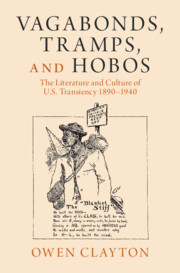Book contents
- Vagabonds, Tramps, and Hobos
- Cambridge Studies in American Literature and Culture
- Vagabonds, Tramps, and Hobos
- Copyright page
- Dedication
- Contents
- Figures
- Acknowledgements
- Part I Context
- Part II The Vagabond and the Tramp
- 2 In Search of Experience: Vagabond Travel Narratives
- 3 Vulnerable Youth and Hobosexuality in the Works of Jack London and A-No.1
- 4 ‘That’s Why the Lady Is a Tramp’: The Hidden Story of Female Transiency
- Part III The Hobo Transformed
- Conclusion: The End of the Road? Transiency beyond the Hobo
- Notes
- Bibliography
- Index
- Recent books in this series (continued from page ii)
3 - Vulnerable Youth and Hobosexuality in the Works of Jack London and A-No.1
from Part II - The Vagabond and the Tramp
Published online by Cambridge University Press: 27 July 2023
- Vagabonds, Tramps, and Hobos
- Cambridge Studies in American Literature and Culture
- Vagabonds, Tramps, and Hobos
- Copyright page
- Dedication
- Contents
- Figures
- Acknowledgements
- Part I Context
- Part II The Vagabond and the Tramp
- 2 In Search of Experience: Vagabond Travel Narratives
- 3 Vulnerable Youth and Hobosexuality in the Works of Jack London and A-No.1
- 4 ‘That’s Why the Lady Is a Tramp’: The Hidden Story of Female Transiency
- Part III The Hobo Transformed
- Conclusion: The End of the Road? Transiency beyond the Hobo
- Notes
- Bibliography
- Index
- Recent books in this series (continued from page ii)
Summary
Chapter Three compares the representation of vulnerable transient youth in the work of Leon Ray Livingston, whose road name was ‘A-No.1’, and the author Jack London. The chapter argues that both writers engage with the frequent abuse and exploitation of young boys, known as ‘punks’ or ‘gay-cats’, on the road. A-No.1’s semi-autobiographical writings are more explicit, obsessively reproducing the same narrative in which the author (or his fictional stand-in) saves a punk from the clutches of an older hobo, or ‘jocker’. For London, who was at the very least what today would be called bi-curious, the questions of transient sexuality and abuse were more fraught. He acknowledges the existence of sexually-vulnerable youths in early stories, written before he became a successful author. However, in his well-known work The Road (1907) he goes to great lengths to persuade his audience that he was never a gay-cat. The text positions London as a young man well ahead of his time, a claim that many critics have taken at face value. Yet paradoxically the text’s narrator seeks out the approval and protection of older men, including one who seems to expect sexual favours in return.
Keywords
- Type
- Chapter
- Information
- Vagabonds, Tramps, and HobosThe Literature and Culture of U.S. Transiency 1890–1940, pp. 79 - 106Publisher: Cambridge University PressPrint publication year: 2023



